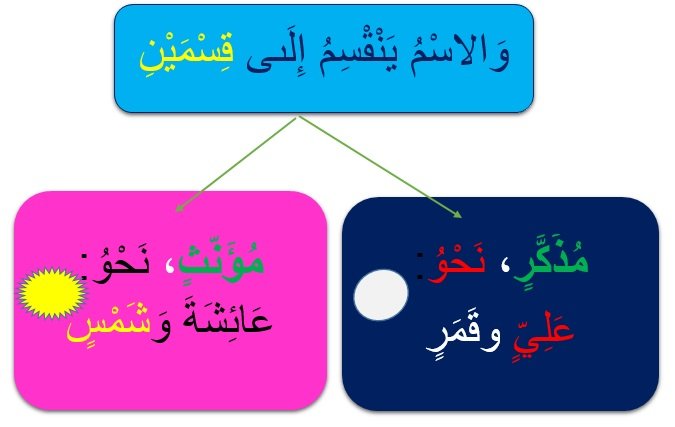
الْمُذَكَّر وَالْمُؤَنَّث
| وَالاسْمُ يَنْقَسِمُ إِلَى قِسْمَيْنِ: مُذَكَّر، نَحْوُ: “عَلِيٍّ”، وَ”جَمَلٍ”، وَ”حِصَانٍ”، وَمُؤَنَّثٍ، نَحْوُ: “عَائِشَةَ”، وَ”نَاقَةٍ” وَ”هِرَّةٍ” The الاسْم is divided into two categories: مُذَكَّر (masculine), like: “عَلِيّ” (Ali), “جَمَل” (camel) and “حِصَان” (stallion), andمُؤَنَّث (feminine), like: “عَائِشَة” (Aishah), “نَاقَة” (she-camel) and “هِرَّة” (female-cat) |
Explanation:
You already know that:
- the الْكَلِمَة is of three types: فِعْل (verb), اسْم (noun) and حَرْف (particle), and
- the الْفِعْل in turn is of three types: مَاضٍ (past), مُضَارِع (present or future) and أَمْر (command).
Know now that the الاسْم is of two types:
- مُذَكَّر (masculine), which is every اسْم that denotes a male, like: “عَلِيّ” (Ali), “حُسَيْن” (Husain), “جَمَل” (camel), “بَغْل” (mule), “حِصَان” (stallion), “حِمَار” (donkey), “هِرّ” (cat), etc.
- مُؤَنَّث (feminine), which is every اسْم that denotes a female, like: “عَائِشَة” (Aishah), “فَاطِمَة” (Fatimah), “عَزِيْزَة” (Azizah), “نَاقَة” (she-camel), “بَغْلَة” (female mule), حِمَارَة” (female donkey), “هِرَّة” (female cat), etc.
[The الْمُذَكَّر can either be مُذَكَّر :
- in meaning and in form like “عَلِيّ” , “جَمَل” , etc. or
- in meaning only like “حَمْزَة” (Hamzah), “طَلْحَة” (Talhah), etc. or
- in form only, like “كِتَاب” (book), “قَلَم” (pen), etc.
Similarly, the الْمُؤَنَّث can either be مُؤَنَّث :
- in meaning and in form like “عائِشَة” , “نَاقَة” , etc. or,
- in meaning only like “زَيْنَب” (Zainab), “هِنْد” (Hind), etc. or
- in form only, like “حَمْزَة” (Hamzah), “طَلْحَة” (Talhah), etc.]